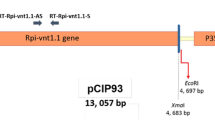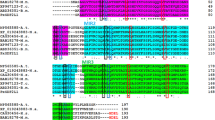Abstract
The understanding of the molecular biology of Polymyxa betae, the protist vector of Beet necrotic yellow vein virus, remains limited because of the obligate nature of this root endoparasite and the limited data on the genome of Beta vulgaris, its most common host plant. The aim of this work was to assess the infection of P. betae in Arabidopsis thaliana in order to learn more about the P. betae genome and its interaction with the host. The susceptibility of a set of ecotypes of various origins to a monosporosorus and aviruliferous isolate of P. betae was analyzed in a series of bioassays conducted under controlled conditions. P. betae was detected in roots of A. thaliana using light microscopy and PCR. The infection severity was relatively low in this species compared with B. vulgaris, but the different stages of the life cycle were present. The phenotype of P. betae in A. thaliana root cells differed from the phenotype in B. vulgaris: the spore-forming phase was more prevalent in comparison with the sporangial phase, and the sporosori contained a lower number of spores. The compatible interaction between P. betae and A. thaliana obtained after the inoculation of zoospores and optimal conditions for the development of P. betae provide a new model system that can be used to improve the knowledge on the P. betae genome and on the mechanisms of the spore-forming phase of P. betae.





Similar content being viewed by others
References
Abe, N., & Ui, T. (1986). Host range of Polymyxa betae Keskin strains in rhizomania-infested soils of sugar beet in Japan. Annals of the Phytopathological Society of Japan, 53, 394–403.
Archibald, J. M., & Keeling, P. J. (2004). Actin and ubiquitin protein sequences support a cercozoan/Foraminiferan ancestry for the plasmodiophorid plant pathogens. Journal of Eukaryotic Microbiology, 51, 113–118.
Barr, D. J. S. (1979). Morphology and host range of Polymyxa graminis, Polymyxa betae and Ligniera pilorum from Ontario and some other areas. Canadian Journal of Plant Pathology, 1, 85–94.
Barr, K. J., & Asher, M. J. C. (1992). The host range of Polymyxa betae in Britain. Plant Pathology, 41, 64–68.
Barr, K. J., Asher, M. J. C., & Lewis, B. G. (1995). Resistance to Polymyxa betae in wild Beta species. Plant Pathology, 44, 301–307.
Braselton, J. P. (1995). Current status of the plasmodiophorids. Critical Reviews in Microbiology, 21, 263–275.
Braselton, J. P. (2001). Plasmodiophoromycota. In: D. J. McLaughlin et al., (Eds.), The Mycota VII, Part A, systematics and evolution. Berlin, Germany: Springer-Verlag, pp. 81–91
Brodmann, A., Schuller, A., Ludwig-Muller, J., Aeschbacher, R. A., Wiemken, A., Boller, T., et al. (2002). Induction of trehalose in Arabidopsis plants infected with the trehaloseproducing pathogen Plasmodiophora brassicae. Molecular Plant-Microbe Interactions, 15, 693–700.
Bulman, S. R., Kühn, S. F., Marshall, J. W., & Schnepf, E. (2001). A phylogenetic analysis of the SSU rRNA from members of the Plasmodiophorida and Phagomyxida. Protist, 152, 43–51.
Bulman, S., Siemens, J., Ridgway, H., Eady, C., & Conner, A. (2006). Identification of genes from the obligate intracellular plant pathogen, Plasmodiophora brassicae. FEMS Microbiology Letters, 264, 198–204.
Crutzen, F., Kreit, M., & Bragard, C. (2009). The beet virus Q coat protein readthrough domain is longer than previously reported, with two transmembrane domains. Journal of General Virology, 90, 754–758.
Crutzen, F., Mehrvar, M., Gilmer, D., & Bragard, C. (2009). A full-length infectious clone of beet soil-borne virus indicates the dispensability of the RNA-2 for virus survival in planta and symptom expression on Chenopodium quinoa leaves. Journal of General Virology, 90, 3051–3056.
Delfosse, P., Reddy, S. A., Legrève, A., Thirumala Devi, K., Abdurahman, M. D., Maraite, H., et al. (2000). Serological methods for detection of Polymyxa graminis, an obligate root parasite and vector of plant viruses. Virology, 90, 537–545.
Desoignies, N., Eickermann, M., Delfosse, P., Kremer, F., Godart, N., Hoffmann, L., et al. (2009). First report of Plasmodiophora brassicae on rapeseed in the Grand Duchy of Luxembourg. Plant Disease, 93, 1220.
Fujisawa, I., & Sugimoto, T. (1976). Transmission of beet necrotic yellow vein virus by Polymyxa betae. Annals of the Phytopathological Society of Japan, 43, 583–586.
Grishkan, I., Korol, A. B., Neve, E., & Wasser, P. (2003). Ecological stress and sex evolution in soil microfungi. Proceedings of the Royal Society of London. Series B. Biological Sciences, 270, 13–18.
Keskin, B. (1964). Polymyxa betae n.sp., ein Parasit in den Wurzeln von Beta vulgaris Tournefort, besonders während der Jugendentwicklung der Zuckerrübe. Archives of Microbiology, 49, 348–374.
Kobelt, P., Siemens, J., & Sacristan, M. D. (2000). Histological characterisation of the incompatible interaction between Arabidopsis thaliana and the obligate biotrophic pathogen Plasmodiophora brassicae. Mycological Research, 104, 220–225.
Koch, E., Cox, R., & Williams, P. H. (1991). Infection of Arabidopsis thaliana by Plasmodiophora brassicae. Journal of Phytopathology, 132, 99–104.
Lee, C.-W., Efetova, M., Engelmann, J. C., Kramell, R., Wasternack, C., Ludwig-Müller, J., et al. (2009). Agrobacterium tumefaciens promotes tumor induction by modulating pathogen defense in Arabidopsis thaliana. Plant Cell, 21, 2948–2962.
Legrève, A., Delfosse, P., Vanpee, B., Goffin, A., & Maraite, H. (1998). Differences in temperature requirements between Polymyxa sp. of Indian origin and Polymyxa graminis and Polymyxa betae from temperature areas. European Journal of Plant Pathology, 104, 195–205.
Legrève, A., Vanpee, B., Delfosse, P., & Maraite, H. (2000). Host range of tropical and sub-tropical isolates of Polymyxa graminis. European Journal of Plant Pathology, 106, 379–389.
Legrève, A., Delfosse, P., & Maraite, H. (2002). Phylogenetic analysis of Polymyxa spp. based on nuclear 5.8 S and internal transcribed spacers ribosomal DNA sequences. Mycological Research, 106, 138–147.
Legrève, A., Delfosse, P., Van Hese, V., Bragard, C., & Maraite, H. (2003). Broad-spectrum detection of Polymyxa species and form species by polymerase chain reaction. In: C. M. Rush & U. Merz (Eds). Proceedings of the fifth Symposium of the International Working Group on Plant Viruses with Fungal Vectors, 22–25 July 2002, IPS, Zurich, Switzerland. pp. 40–43 Denver, USA: American Society of Sugar Beet Technologists)
Legrève, A., Schmit, J. F., Bragard, C., & Maraite H. (2005). The role of climate and Alternative hosts in the epidemiology of rhizomania. In: C. M. Rush (Ed.), Proceedings of the sixth Symposium of the International Working Group on Plant Viruses with Fungal Vectors, 5–7 September 2005, Bologna Italy. (pp. 125–128). Denver, USA: American Society of Sugar Beet Technologists).
Littlefield, L. J., Whallon, J. H., Doss, P. J., & Hassan, Z. M. (1998). Post infection development of Polymyxa graminis in roots of Triticum aestivum. Mycologia, 90, 869–882.
McGrann, G. R. D., Martin, L. D., Kingsnorth, C. S., Asher, M. J. C., Adams, M. J., & Mutasa-Göttgens, E. S. (2007). Screening for genetic elements involved in the nonhost response of sugar beet to the plasmodiophorid cereal root parasite Polymyxa graminis by representational difference analysis. Journal of General Plant Pathology, 73, 260–265.
McGrann, G. R. D., Townsend, B. J., Antoniw, J. F., Asher, M. J. C., & Mutasa-Göttgens, E. S. (2009). Barley elicits a similar early basal defence response during host and non-host interactions with Polymyxa root parasites. European journal of Plant Pathology, 123, 5–15.
Mutasa-Göttgens, E. S., Ward, E., Adams, M. J., Collier, C., Chwarszczynska, D. M., & Asher, M. J. C. (1993). A sensitive DNA probe for the detection of Polymyxa betae in sugar beet roots. Physiological and Molecular Plant Pathology, 43, 379–390.
Mutasa-Göttgens, E. S., Chwarszczynska, D. M., Halsey, K., & Asher, M. J. (2005). Specific polyclonal antibodies for the obligate plant parasite Polymyxa - a targeted recombinant DNA approach. Plant Pathology, 49, 276–287.
Obermeier, C. (1998). New Diagnostic tools for detection of polymyxa betae in sugar beet roots. PhD Thesis, Technical University Braunschweig, Germany.
Peltier, C., Hleibieh, K., Thiel, H., Klein, E., Bragard, C., & Gilmer, D. (2008). Molecular biology of the beet necrotic yellow vein virus. Plant Viruses, 2, 14–24.
Pferdmenges, F., Korf, H., & Varrelmann, M. (2009). Identification of rhizomania-infected soil in Europe able to overcome /Rz1/ resistance in sugar beet and comparison with other resistance-breaking soils from different geographic origins. European Journal of Plant Pathology, 124, 31–43.
Rush, C. M., Liu, H. Y., Lewellen, R. T., & Acosta-Leal, R. (2006). The Continuing Saga of Rhizomania of Sugar Beets in the United States. Plant Disease, 90, 4–15.
Ruzin, S. E. (1999). Plant microtechnique and microscopy. Oxford: Oxford University Press.
Siemens, J., Keller, I., Sarx, J., Kunz, S., Schuller, A., Nagel, W., et al. (2006). Transcriptome analysis of Arabidopsis clubroots indicate a key role for cytokinins in disease development. Molecular Plant-Microbe Interactions., 19, 480–494.
Thatcher, L. F., Manners, J. M., & Kazan, K. (2009). Fusarium oxysporum hijacks COI1-mediated jasmonate signaling to promote disease development in Arabidopsis. The Plant Journal., 58, 927–939.
Ward, E., & Adams, M. J. (1998). Analysis of ribosomal DNA sequences of Polymyxa species and related fungi and the development of genus- and species- specific PCR primers. Mycological Research, 102, 965–974.
Wisler, G. C., Liu, H. Y., & Duffus, J. E. (1994). Beet necrotic yellow vein virus and its relationship to eight sugar beet furo-like viruses from the United States. Plant Disease, 78, 995–1001.
Yuan, J., Zhu, M., Lightfoot, D. A., Iqbal, M. J., & Meksem, K. (2008). In silico comparison of transcript abundances during Arabidopsis thaliana and Glycine max resistance to Fusarium virguliforme. BMC Genomics, 9(Suppl 2), S6.
Acknowledgements
We thank François Crutzen, Benjamin Dieryck, Yann Galein and Jeannine Weyns for their scientific advice and help. Nicolas Desoignies is a fellow of UCL Special Research Funds (FSR) and the Belgian FRIA fund.
Author information
Authors and Affiliations
Corresponding author
Rights and permissions
About this article
Cite this article
Desoignies, N., Stocco, C., Bragard, C. et al. A new phenotype of Polymyxa betae in Arabidopsis thaliana . Eur J Plant Pathol 131, 27–38 (2011). https://doi.org/10.1007/s10658-011-9783-5
Accepted:
Published:
Issue Date:
DOI: https://doi.org/10.1007/s10658-011-9783-5




